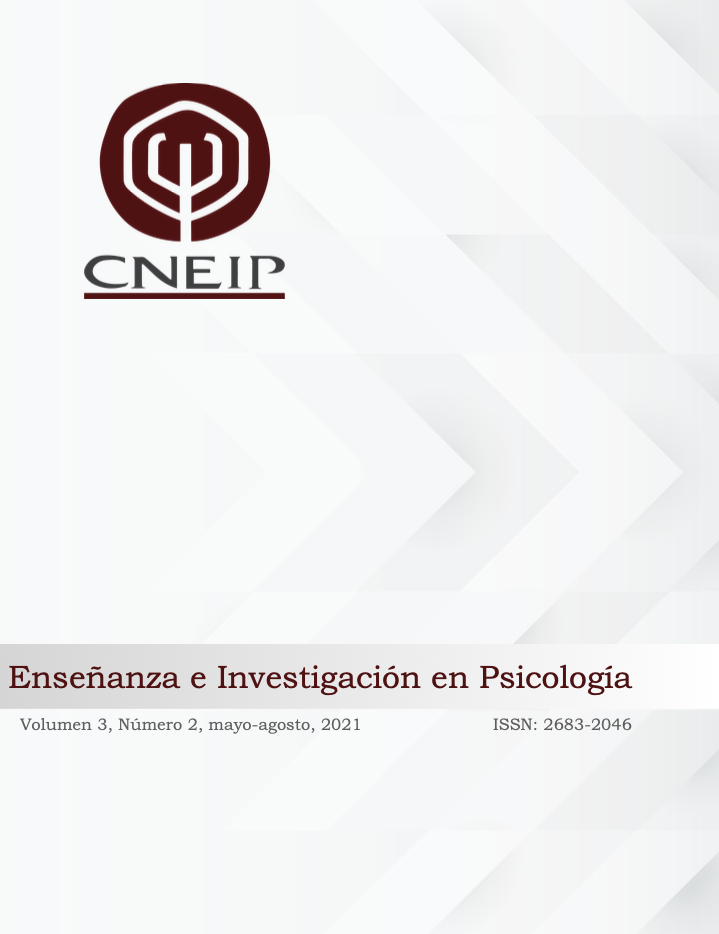Resumen
En México existen problemas de estigma y autoestigma relacionados con la salud mental, además, existe poca búsqueda para recibir tratamiento mental profesional. En este estudio se analiza la relación del autoestigma y actitudes hacia la búsqueda de tratamiento (AEABT) de salud mental con los factores de la Escala Multidimensional de Fatalismo que incluye el fatalismo y constructos relacionados. El estudio se hizo con una muestra de 140 participantes de Ciudad Juárez con una media de edad de 35.94 años (DE = 14.10) y con el 68.6% del sexo femenino. Los principales resultados es que el pesimismo fue el factor que tuvo correlaciones más fuertes con el AEABT, sin embargo, también los factores de suerte, fatalismo y control divino tuvieron correlaciones estadísticamente significativas. Por último, las respuestas a las escalas de AEABT indican niveles altos en autoestigma y niveles bajos en las actitudes hacia la búsqueda de tratamiento.
Referencias
Andrade, L. H., Alonso, J., Mneimneh, Z., Wells, J. E., Al-Hamzawi, A., Borges, G., Bromet, E.,
Bruffaerts, R., de Girolamo, G., de Graaf, R., Florescu, S., Gureje, O., Hinkov, H. R., Hu,
C., Huang, Y., Hwang, I., Jin, R., Karam, E. G., Kovess-Masfety, V.,… Kessler, R. C. (2014). Barriers to mental health treatment: results from the WHO World Mental Health surveys.
Psychological Medicine, 44(6), 1303–1317. https://doi.org/10.1017/S0033291713001943
Andrade, L., Caraveo-Anduaga, J. J., Berglund, P., Bijl, R., Kessler, R. C., Demler, O., Walters, E.,
Kýlýҫ, C., Offord, D., Üstün. T. B. y Wittchen, H. U. (2000). Cross-national comparisons of the prevalences and correlates of mental disorders. Bulletin of the World Health Organization,
78(4), 413–426. https://apps.who.int/iris/handle/10665/57240
Angermeyer, M. C. y Dietrich, S. (2006). Public beliefs about and attitudes towards people with mental illness: a review of population studies. Acta Psychiatrica Scandinavica, 113(3), 163–
179. https://doi.org/10.1111/j.1600-0447.2005.00699.x
Benjet, C., Borges, G., Medina-Mora, M. E., Fleiz-Bautista, C. y Zambrano-Ruiz, J. (2004). La depresión con inicio temprano: prevalencia, curso natural y latencia para buscar tratamiento. Salud Pública de México, 46(5), 417-424. https://www.saludpublica.mx/index.php/spm/article/view/6559
Benjet, C., Borges, G., Stein, D. J., Méndez, E. y Medina-Mora, M. E. (2012). Epidemiology of fears and specific phobia in adolescence: Results from the Mexican Adolescent Mental Health Survey. The Journal of Clinical Psychiatry, 73(2), 152–158. https://doi.org/10.4088/ JCP.11m07442
Borges, G., Medina-Mora, M. E., Wang, P. S., Lara, C., Berglund, P. y Walters, E. (2006). Treatment and adequacy of treatment of mental disorders among respondents to the Mexico National
Comorbidity Survey. American Journal of Psychiatry, 163(8), 1371–1378. https://doi.org/
10.1176/ajp.2006.163.8.1371
Cohen, J. (1992). A power primer. Psychological Bulletin, 112(1), 155–159. https://doi.org/
10.1037//0033-2909.112.1.155
Corrigan, P. W., Larson, J. E. y Kuwara, S. A. (2010). Social psychology of the stigma of mental illness. En J. E. Maddux y J. P. Tagney (Eds.), Social psychological foundations of clinical psychology (pp. 51-68). The Guliford Press.
Corrigan, P. W. y Rao, D. (2012). On the self-stigma of mental illness: Stages, disclosure, and strategies for change. The Canadian Journal of Psychiatry, 57(8), 464–469. https://doi.org/ 10.1177/070674371205700804
Corrigan, P.W., Watson, A. y Barr, L. (2006). The self-stigma of mental illness: Implications for self-esteem and self-efficacy. Journal of Social & Clinical Psychology, 25(9), 875–884.
https://doi.org/10.1521/jscp.2006.25.8.875
Crisp, A. H., Gelder, M. G., Rix, S., Meltzer, H. I. y Rowlands, O. J. (2000). Stigmatisation of people with mental illnesses. British Journal of Psychiatry, 177(1), 4–7. https://doi.org/10.1192/ bjp.177.1.4
Esparza, O. A., Wiebe, J. S. y Quiñones, J. (2015). Simultaneous development of a multidimensional fatalism measure in English and Spanish. Current Psychology, 34(4), 597-612. https://doi.org/10.1007/s12144-014-9272-z
Fischer, E. H. y Farina A. (1995). Attitudes toward seeking professional psychological help: a shortened form and considerations for research. Journal of College Student Development, 36(4),
368-373. https://doi.org/10.3389/fpsyg.2016.00547
Kalichman, S. C., Kelley, J. A., Morgan, M., y Rompa, D. (1997). Fatalism, current life satisfaction, and risk for HIV infection among gay and bisexual men. Journal of Consulting and Clinical Psychology, 65(4), 542-546. https://doi.org/10.1037/0022-006X.65.4.542
Link, B. G., Cullen, F. T., Struening, E., Shrout, P. E. y Dohrenwend, B. P. (1989). A modified labelling theory approach to mental disorders: An empirical assessment. American Sociological Review, 54(3), 400-423. https://doi.org/10.2307/2095613
Lipkus, I. (1991). The construction and preliminary validation of a global belief in a just world scale and the exploratory analysis of the multidimensional belief in a just world scale. Personality & Individual Differences, 12(11), 1171-1178. https://doi.org/10.1016/0191-8869(91)90081-L Maercker, A., Ben-Ezra, M., Esparza, O. A. y Augsburger, M. (2019). Fatalism as a traditional cultural belief potentially relevant to trauma sequelae: Measurement equivalence, extent and associations in six countries. European Journal of Psychotraumatology, 10(1), 1–11. https://doi-org.ezproxy.uacj.mx/10.1080/20008198.2019.1657371
Maharjan, S. y Panthee, B. (2019). Prevalence of self-stigma and its association with self-esteem among psychiatric patients in a Nepalese teaching hospital: a cross-sectional study. BMC Psychiatry, 19(1), 347. https://doi.org/10.1186/s12888-019-2344-8
Mascayano, F., Lips, W., Mena, C. y Manchego, C. (2015). Estigma hacia los trastornos mentales: Características e intervenciones. Salud Mental, 38(1), 53-58. https://doi.org/10.17711/ SM.0185-3325.2015.007
Medina-Mora, M. E., Borges, G., Benjet, C., Lara, C. y Berglund, P. (2007). Psychiatric disorders in Mexico: lifetime prevalence in a nationally representative sample. The British Journal of Psychiatry, 190(6), 521–528. https://doi.org/10.1192/bjp.bp.106.025841M
Montero, I. y León, O. G. (2007). A guide for naming research studies in psychology. International Journal of Clinical and Health Psychology, 7(3), 847–862. http://www.aepc.es/ijchp/articulos.php?coid=English&id=256
Mora-Rios, J., Bautista-Aguilar, N., Natera, G. y Pedersen D. (2013). Adaptación cultural de instrumentos de medida sobre estigma y enfermedad mental en la Ciudad de México. Salud Mental, 36(1), 9-18. https://doi.org/10.17711/SM.0185-3325.2013.002
Mora-Ríos, J., Ortega-Ortega, M. y Medina-Mora, M. E. (2017). Addiction-Related Stigma and Discrimination: A Qualitative Study in Treatment Centers in Mexico City. Substance Use &
Misuse, 52(5), 594–603. https://doi.org/10.1080/10826084.2016.1245744
Quiñones, J., Esparza, O. A. y Carrillo, I. C. (2013). La violencia en Ciudad Juárez: Una mirada psicológica en perspectiva multifactorial. Universidad Autónoma de Ciudad Juárez.
Rafful, C., Medina-Mora, M. E., Borges, G., Benjet, C. y Orozco, R. (2012). Depression, gender, and the treatment gap in Mexico. Journal of Affective Disorders, 138(1-2), 165–169.
https://doi.org/10.1016/j.jad.2011.12.040
Ribeiro, W. S., Andreoli, S. B., Ferri, C. P., Prince, M. y Mari, J. J. (2009). Exposure to violence and mental health problems in low and middle-income countries: a literature review. Revista Brasileira de Psiquiatría, 31(2), S49–S57. https://doi.org/10.1590/s1516-44462009000600003
Ritsher, J. B., Otilingam, P. G. y Grajales, M. (2003). Internalized stigma of mental illness: Psychometric properties of a new measure. Psychiatry Research, 121(1), 31-49. https://doi.org/ 10.1016/j.psychres.2003.08.008
Ross, C. E., Mirowsky, J. y Cockerham, W. C. (1983). Social class, Mexican culture, and fatalism: Their effects on psychological distress. American Journal of Community Psychology, 11(4),
383-399. https://doi.org/10.1007/bf00894055
Ruscio, A. M., Hallion, L. S., Lim, C., Aguilar-Gaxiola, S., Al-Hamzawi, A., Alonso, J., Andrade, L. H., Borges, G., Bromet, E. J., Bunting, B., Caldas de Almeida, J. M., Demyttenaere, K., Florescu, S., de Girolamo, G., Gureje, O., Haro, J. M., He, Y., Hinkov, H., Hu, C.,… Scott, K. M. (2017). Cross-sectional Comparison of the Epidemiology of DSM-5 Generalized Anxiety Disorder Across the Globe. Journal of the American Medical Association Psychiatry,
74(5), 465–475. https://doi.org/10.1001/jamapsychiatry.2017.0056
Subramaniam, M., Abdin, E., Picco, L., Shahwan S., Jeyagurunathan, A., Vaingankar, J. A. y Chong, S. A. (2017). Continuum beliefs and stigmatising beliefs about mental illness: Results from an Asian community survey. British Medical Journal Open, 7(4), 1-10. http://dx.doi.org/ 10.1136/bmjopen-2016-014993
Thornicroft, G., Chatterji, S., Evans-Lacko, S., Gruber, M., Sampson, N., Aguilar-Gaxiola, S., AlHamzawi, A., Alonso, J., Andrade, L., Borges, G., Bruffaerts, R., Bunting, B., de Almeida, J. M., Florescu, S., de Girolamo, G., Gureje, O., Haro, J. M., He, Y., Hinkov, H.,… Kessler, R.
C. (2017). Undertreatment of people with major depressive disorder in 21 countries. The
British journal of psychiatry: the journal of mental science, 210(2), 119–124. https://doi.org/
10.1192/bjp.bp.116.188078
Torres, L., Magnus, B. y Najar, N. (2021). Assessing the psychometric properties of the Attitudes Toward Seeking Professional Psychological Help Scale – Short form (ATSPPH–SF) among Latino adults. Assessment, 28(1), 1-14. https://doi.org/10.1177/1073191119899470
Williamson, A. M., Feyer, A. M., Cairns, D. y Biancotti, D. (1997). The development of a measure of safety climate: The role of safety perceptions and attitudes. Safety Science, 25(1), 15-27.

Esta obra está bajo una licencia internacional Creative Commons Atribución-NoComercial-SinDerivadas 4.0.
Derechos de autor 2021 Revista Enseñanza e Investigación en Psicología





